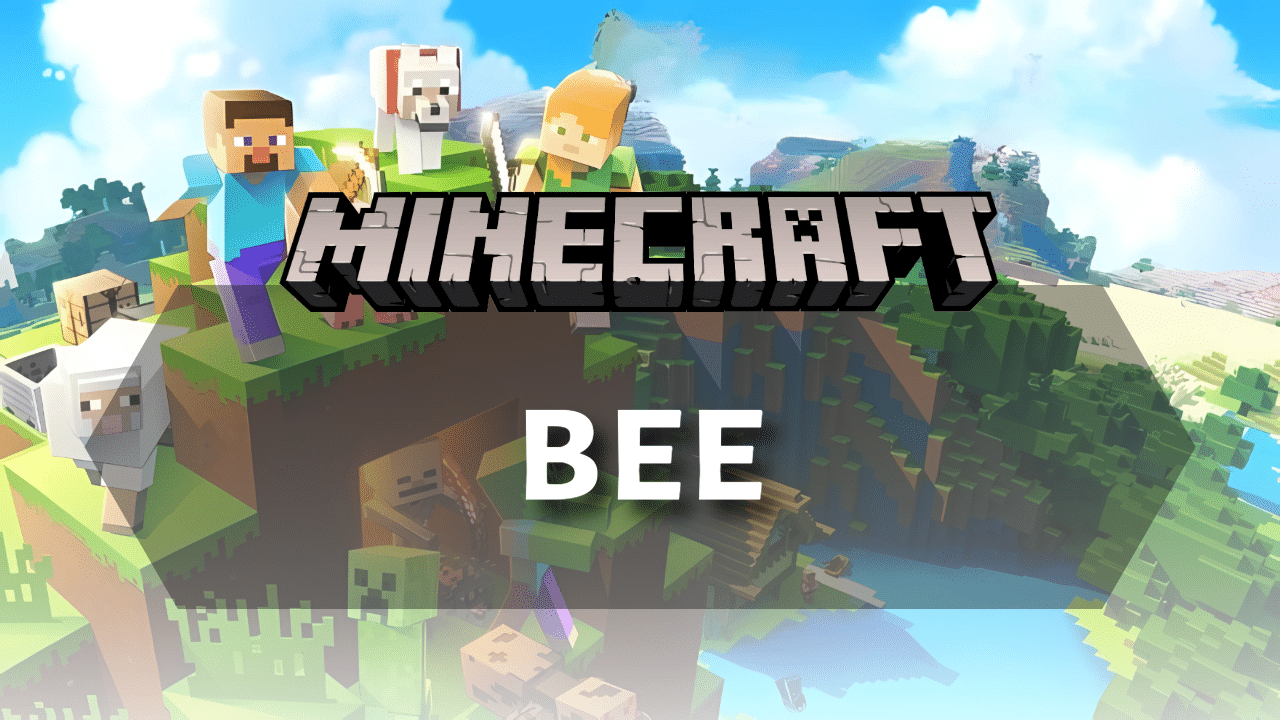
Introduction
Bees are fascinating flying neutral mobs in Minecraft that were introduced to enhance the game’s natural world with their unique behaviors and valuable resources. They play a crucial role in pollination and provide players with honey and honeycomb, which have a variety of uses from food and crafting to even redstone contraptions. This Minecraft Bedrock Bee Guide will cover everything you need to know about interacting with bees in Minecraft Bedrock Edition.
Finding Bees
In Bedrock Edition, bees spawn in bee nests that naturally generate on oak, birch, or cherry trees in specific biomes. Meadows offer the highest chance of spawning, as every naturally generated tree in this biome can have a bee nest. This makes meadows one of the best places to start your search if you want to quickly establish a bee farm.
Plains and sunflower plains come next, with each tree having a 5% chance to spawn a nest. These are more common biomes, making them convenient locations despite the lower odds. The flower forest biome has a slightly lower 3% chance of generating bee nests, but it’s filled with flowers, which helps with bee productivity. Mangrove swamps also offer a 5% chance, though they can be trickier to navigate due to terrain. Forest, birch forest, and old growth birch forest have a very low spawn rate of 0.035%, so they are generally not ideal for finding bees.
Cherry groves also offer a chance for nests to generate and make for a visually appealing bee environment. Additionally, if you plant oak, birch, or cherry saplings near flowers (within two blocks), there’s a 5% chance that a bee nest will spawn on the tree once it grows. This method allows players to farm bee nests more reliably near their base.
Bee Behavior
Bees in Bedrock Edition are neutral mobs that won’t attack unless provoked. If you hit a bee, break its nest or hive without Silk Touch, or harvest honey or honeycomb without calming the bees, they will become aggressive. Once angry, bees attack by stinging their target, which causes them to lose their stinger and die within a minute.
During the day, bees fly around in search of flowers to collect pollen, traveling up to 22 blocks from their home. When they find a flower, they circle it for around 30 seconds to gather pollen, which is visible as particles and spots on their body. Bees carrying pollen can pollinate crops, helping them grow faster, similar to using bone meal. Each pollen-loaded bee can pollinate up to ten plants, making them valuable for farming.
After collecting pollen, bees return to their hive or nest, and if they make it back safely, the honey level of the hive increases. This level rises gradually with each return, and when it reaches five, the hive or nest becomes harvestable and will visibly drip honey. Bees always return home at night or when it rains, and after two minutes inside, they exit and resume their activity. They hover rather than truly fly, typically staying a few blocks above ground, and are classified as arthropods—meaning they take extra damage from the Bane of Arthropods enchantment. In Bedrock Edition, bees are immune to water damage, unlike in Java Edition.
Bee Nests vs. Beehives
Bee nests are naturally generated structures that appear attached to trees in specific biomes and cannot be crafted. To safely collect a bee nest, you need a Silk Touch-enchanted tool; otherwise, breaking it will destroy the nest and provoke the bees. Beehives, on the other hand, are crafted using six wooden planks and three honeycombs. These serve as artificial homes for bees and function exactly like nests in storing bees and honey.
While you can harvest from beehives without Silk Touch, doing so will still anger the bees unless you use smoke to calm them. The key advantage of beehives is their craftability, making them ideal for building custom bee farms. Both nests and hives house up to three bees and can be used to harvest honey and honeycomb. The decision between them often comes down to availability and whether you want to automate or manually manage your bees.
Obtaining Bees
You can acquire bees by relocating natural bee nests, crafting beehives, breeding bees, or using leads to transport them. To move a bee nest, you must use a Silk Touch tool to preserve the nest and the bees inside. Once placed again, the bees will resume their routines as if nothing changed. Crafting a beehive allows you to create a custom bee home anywhere you like, especially near your base. Place flowers nearby, and any homeless bees will eventually adopt the hive as their own.
Breeding bees is another effective method for expanding your bee population. Simply feed two adult bees a flower, and they will produce a baby bee. You can also attach leads to bees and guide them to a new location, which is especially useful when relocating them from distant biomes. Bees on leads follow relatively closely, though you’ll want to avoid hazards along the way. Once you’ve got a couple of bees at your base, it becomes easy to grow your colony using flowers and hive management.
Breeding Bees
To breed bees, you’ll need any flower type that bees are attracted to. These include any 1- or 2-block tall flower (except closed eyeblossom), flowering azalea, cherry leaves, spore blossom, and more. Right-clicking two adult bees while holding a flower puts them into love mode, spawning a baby bee.
The baby bee takes around 20 minutes to mature, though feeding it more flowers reduces its growth time by 10% per flower. Breeding regularly helps create a sustainable bee population and ensures a continuous supply of honey and honeycomb. It’s important to note that when bees are inside a hive or nest, their growth timer pauses. For this reason, it’s more efficient to keep young bees outside until they grow up.
Harvesting Honey and Honeycomb
When a hive or nest reaches honey level 5, it becomes harvestable. Use a glass bottle to collect honey, or shears to collect honeycomb from a full hive. Harvesting without precautions will anger the bees, which can be dangerous if you’re not prepared. To prevent aggression, place a lit campfire beneath the hive or nest. This calms nearby bees, allowing safe harvesting.
The campfire should be directly underneath and unobstructed; otherwise, the smoke won’t reach the bees. Another option is to use a dispenser with either bottles or shears, which automates the collection process without angering the bees. Dispensers can be activated with redstone and don’t cause aggression, making them ideal for automated farms. When using shears in a dispenser, three honeycombs drop as items and can be collected with hoppers.
Bee Products and Their Uses
Bees provide two main resources: honey and honeycomb, each with multiple applications that go beyond just farming.
Honey bottles restore 3 hunger points and cure poison effects when consumed, making them a useful emergency food, especially when exploring areas with poisonous mobs like cave spiders or witches. They can be crafted into honey blocks using four bottles. Honey blocks are useful in redstone contraptions and parkour due to their sticky, slowing properties—they can pull adjacent blocks when moved by pistons and allow players or mobs to slide down their sides to reduce or negate fall damage. In tight redstone builds, honey blocks are often preferred over slime blocks since entities stuck to honey blocks don’t bounce, and redstone doesn’t stick to them. This gives players new movement and automation possibilities.
Additionally, each honey bottle can be crafted into three sugar, offering a renewable alternative to harvesting sugar cane. This is helpful in large-scale baking operations or potion brewing, especially if your world lacks sugar cane farms.
Honeycombs have a range of practical and decorative uses. Three honeycombs and six planks craft a beehive—crucial for expanding your bee farm and relocating colonies to controlled environments. They can also be crafted into honeycomb blocks, which are decorative blocks with a bright yellow hexagonal pattern, often used in themed builds or honey factory designs.
One honeycomb can also craft a candle, which can be placed on solid blocks as a decorative light source. Candles can be dyed into any of the 16 standard colors and lit with a flint and steel. They add ambiance to builds and can be placed singly or in groups of up to four per block to adjust the brightness. Redstone can also be used to turn them on or off indirectly.
Another major use of honeycombs is waxing copper blocks. When applied to copper blocks using right-click or tap-and-hold (on touch), honeycomb prevents oxidation, locking the block’s current color and keeping it from aging to green. This is especially important for builders who want a specific copper color stage to stay permanent. If you change your mind, you can use an axe to scrape the wax off and allow oxidation to resume.
Beyond physical items, bees themselves contribute to agriculture by pollinating crops. As they fly between flowers and return to their hives, they can accelerate the growth of nearby wheat, potatoes, carrots, beetroots, melons, and pumpkins. This makes bees useful in semi-automated farms where crop yield speed matters. Bees can be incorporated into greenhouse-style farms, where they provide both aesthetic charm and practical farming enhancements.
Bees are also featured in a few achievements and hidden mechanics, such as being arthropods (affected by the Bane of Arthropods enchantment) and being the only arthropods that spawn in Peaceful mode. In creative builds or adventure maps, bees can be used as ambient mobs to create lifelike ecosystems and make natural areas feel alive.
Lastly, bees offer educational value through their mechanics, mimicking real-world pollination behavior, colony structure, and resource cycles. This makes them great for classroom learning environments or educational worlds designed in Minecraft.
Honey Blocks
Honey blocks are crafted from four honey bottles and have unique properties. They are sticky and slow down movement, prevent jumping, and pull nearby blocks along when moved with pistons. These features are valuable for redstone and parkour mechanics. Landing on a honey block reduces fall damage by 80%, and sliding down them eliminates fall damage entirely. This makes them perfect for elevators or hidden entrances in builds. Honey blocks can also move items and mobs when attached to pistons, like slime blocks, but they don’t transmit redstone signals. Their slightly smaller hitbox can be exploited in advanced redstone contraptions or for aesthetic builds.
Bee Farming
To create a bee farm, gather several hives or nests and plant flowers within a 22-block radius. Enclosing the area ensures bees don’t wander off and makes harvesting more manageable. Manual harvesting with campfires is simple, but automation with dispensers and redstone greatly boosts efficiency. Dispensers can be triggered when the hive reaches honey level 5, automatically collecting honey or honeycombs. Use hoppers and chests to store the collected items and streamline your resource management. Building bee farms in the Nether or End avoids issues with rain and nighttime, which otherwise pause bee activity in the Overworld.
Keeping Bees Safe
Protect your bees from hostile mobs by fencing the farm and placing torches. Zombies and spiders may interfere with bee activity or damage the hives. Bees are also vulnerable to hazards like lava, cactus, and berry bushes—though in Bedrock Edition, berry bushes no longer harm them. Keep hives away from these dangers to avoid accidental deaths. Avoid hitting bees or breaking their hives without precautions, as this will provoke them. Enclosing your bee farm in glass or walls can help prevent bees from wandering off, especially if you have lots of flowers nearby that might lure them away.
Achievements and Advancements
There are multiple achievements tied to bee-related activities. “Bee Our Guest” is earned by collecting honey from a hive using a bottle and a campfire to avoid bee aggression. “Total Beelocation” involves moving a full bee nest using Silk Touch and placing it elsewhere. “Sticky Situation” rewards players for sliding down a honey block to slow their fall. Bees also contribute to broader achievements like “The Parrots and the Bats,” which involves breeding any two animals, and “It Spreads,” which tracks mobs killed near a Sculk Catalyst. Completing these tasks adds depth to your gameplay and encourages diverse use of bees.
Trivia
Bees are the only arthropod mob that can appear in Peaceful difficulty, making them unique among hostile-sensitive creatures. Their half-block size was chosen by Mojang for aesthetic cuteness. Interestingly, bees pollinate the top half of sunflowers, which adds a small touch of realism. Bees also have a slight northwest movement bias, so building apiaries to the southeast can help keep them from drifting too far. These quirky behaviors add charm and strategic nuance to bee farming.
Sounds
Bees in Bedrock Edition have a rich set of sound effects. Their death, hurt, and movement sounds are all subtly varied in pitch between adults and babies. Pollination and stinging each have unique audio cues that help players understand what bees are doing. These sound effects are not just immersive—they also help players track bee activity during gameplay. Paying attention to sound can alert you to aggressive bees or when a bee has just stung something.
Data Values
In Bedrock Edition, bees use the identifier bee and numeric ID 122. The translation key is entity.bee.name. They have unique data points such as HasNectar (indicates if they’re carrying pollen), HasStung, HivePos, and FlowerPos. These values help the game track each bee’s behavior and status. Advanced players can use this data for command blocks or custom behaviors in creative builds. Monitoring these tags is useful for creating efficient bee automation systems.
Conclusion
Bees in Minecraft are a versatile and enriching addition to the game, offering both practical resources and immersive mechanics. Found in flower-rich biomes like plains and meadows, bees naturally inhabit nests and can also occupy player-made beehives. Their primary role in the ecosystem is pollination, which not only helps flowers bloom but also accelerates crop growth such as wheat and berries. Bees collect nectar and return to their homes, gradually increasing the honey level, which can be harvested for honey bottles or honeycombs once full.
Interacting with bees requires caution. Harvesting honey without proper preparation—like placing a campfire underneath—will provoke bees, causing them to swarm and inflict poison. However, players can avoid conflict through smart setups, such as using dispensers with bottles or shears triggered by redstone. Bees can also be bred using flowers and relocated via Silk Touch tools or led with leads and flowers, making bee colony management accessible for players at any stage of the game.
The resources produced by bees have a wide range of uses. Honey bottles serve as a food source and can cure poison, while also crafting into honey blocks that are useful in redstone and parkour builds due to their sticky properties. Honeycombs are essential for crafting beehives, candles, honeycomb blocks, and for waxing copper blocks to prevent oxidation. With their diverse functions—spanning farming, building, redstone, and decoration—bees are an essential part of any player’s world, rewarding careful management and creative integration into gameplay.
If you’re looking for more guides, be sure to explore the website for more tips and tricks. Enjoy your adventure, and happy mining!













